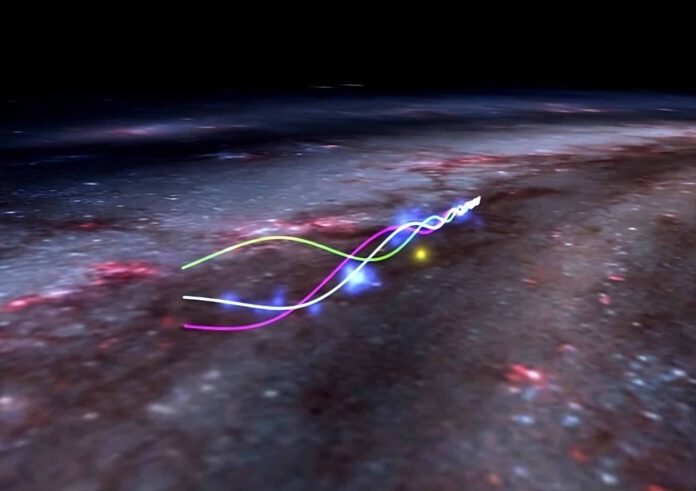
Just a few years ago, astronomers discovered one of the largest secrets of our Milky Way: in our sun’s backyard, there is an enormous wave of gas clouds, where countless stars are born.
The Unveiling of the Radcliff Wave
This unique structure has been named the Radcliff Wave after the Harvard Radcliff Institute that made the discovery. The same researchers now write in Nature that the Radcliff Wave not only looks like a wave but also moves like one. It sways like a snake through space, somewhat similar to “the wave” performed by fans in a stadium.
‘By using the motion of baby stars born in the gas clouds of the Radcliff Wave, we can track their gas movement to show that the Radcliff Wave really does wave,’ explains lead researcher Ralf Konietzka from Harvard.
Discovery of the Radcliff Wave
As early as 2018, astronomers started creating a three-dimensional map of the star nursery in the vicinity of the sun. Using brand new data from ESA’s Gaia mission and a data-guzzling 3D mapping technique, they found a pattern that led to the discovery of the Radcliff Wave in 2020.
“It’s the largest coherent structure we know, and it’s very close to us,” says Harvard researcher Catherine Zucker. “It was there all along. We just didn’t know it, because we couldn’t build such high-resolution 3D models of the distribution of gas clouds near the sun.” Indeed, with a length of 9000 light-years, the Radcliff Wave is gigantic and not too far away, with a distance of 500 light-years from our sun.
Superior Data
The 2020 map clearly showed the existence of the Radcliff Wave, but the measurements were not accurate enough to see if the wave also moves. However, with the help of newer Gaia data, the astronomers were able to better determine the position of the young star clusters in 2022, revealing that the Radcliff Wave indeed wavers.
Astronomers describe it as a ‘traveling wave’ that moves both in space and in time. Accordingly, it closely resembles the wave in a sports stadium. Just like fans standing and sitting in succession, the star clusters also move up and down, forming a pattern that travels throughout the entire region. “And just like fans in a stadium are pulled back into their seats by the Earth’s gravity, the Radcliff Wave ripples due to the Milky Way’s gravity,” says Konietzka.
New Questions Arise
But this knowledge raises even more intriguing questions, as no one knows what causes the Radcliff Wave and why it moves in this way. “Now we can test all sorts of different theories about why this wave formed in the first place,” says Zucker. “These theories range from supernova explosions to collisions of dwarf satellite galaxies with our Milky Way.”
Dark Matter
The researchers already know something about the amount of dark matter needed for the gravity that causes the wave motion. “It turns out that there is actually hardly any dark matter needed to explain the motion we see,” replies Konietzka. “The gravity of ordinary matter alone is enough to get the wave moving.”
The discovery also leads to the question of how important such waves are in the Milky Way and beyond. As the Radcliff Wave appears to form the backbone of the nearest spiral arm in the Milky Way, it suggests that the arms of galaxies may always oscillate, making galaxies even more dynamic than previously thought.
“The question is what causes the shift that leads to the waving we see,” says researcher Alyssa Goodman. “And does it happen everywhere in the galaxy? Or even in all galaxies? And does it happen intermittently or continuously?” The discovery of the wavering wave, thus, raises more questions than it answers.











